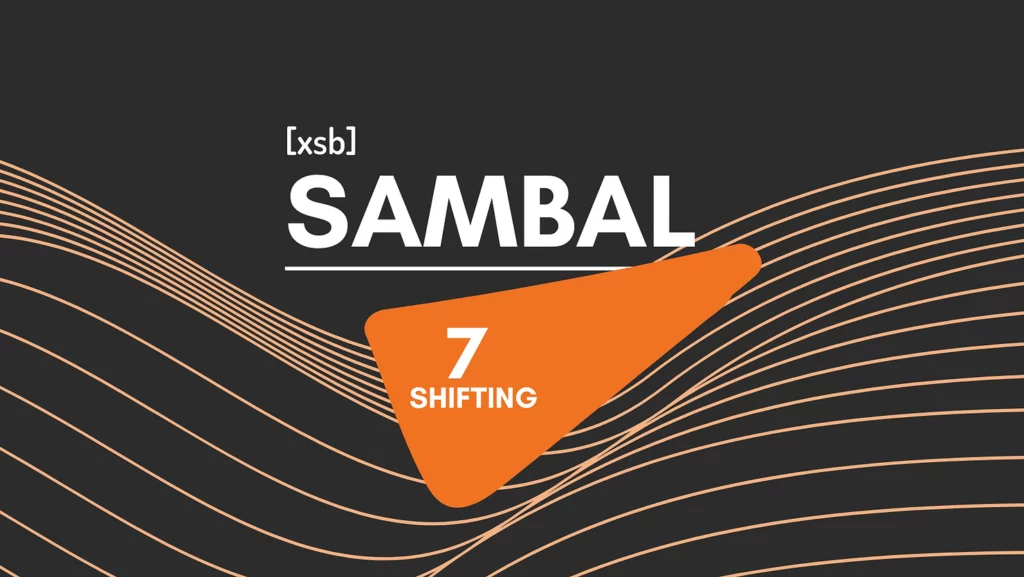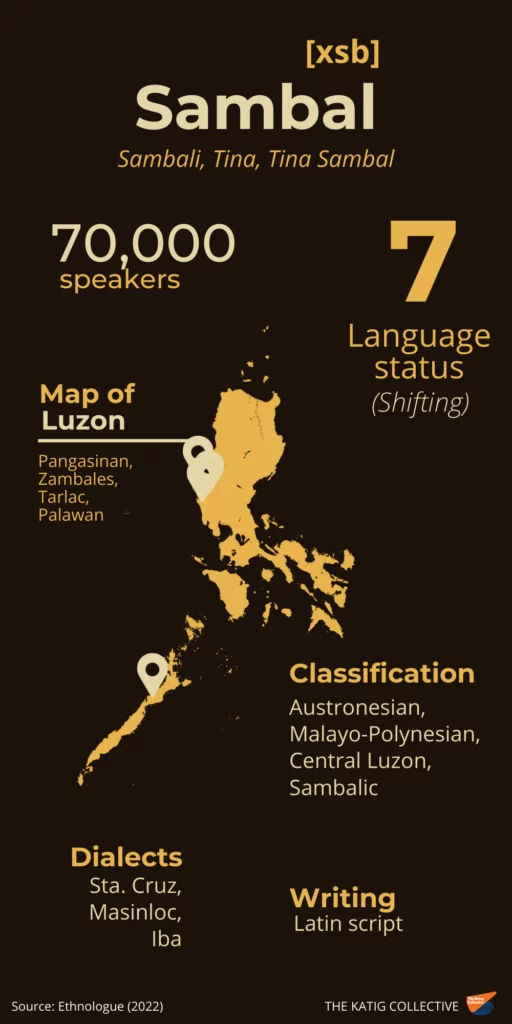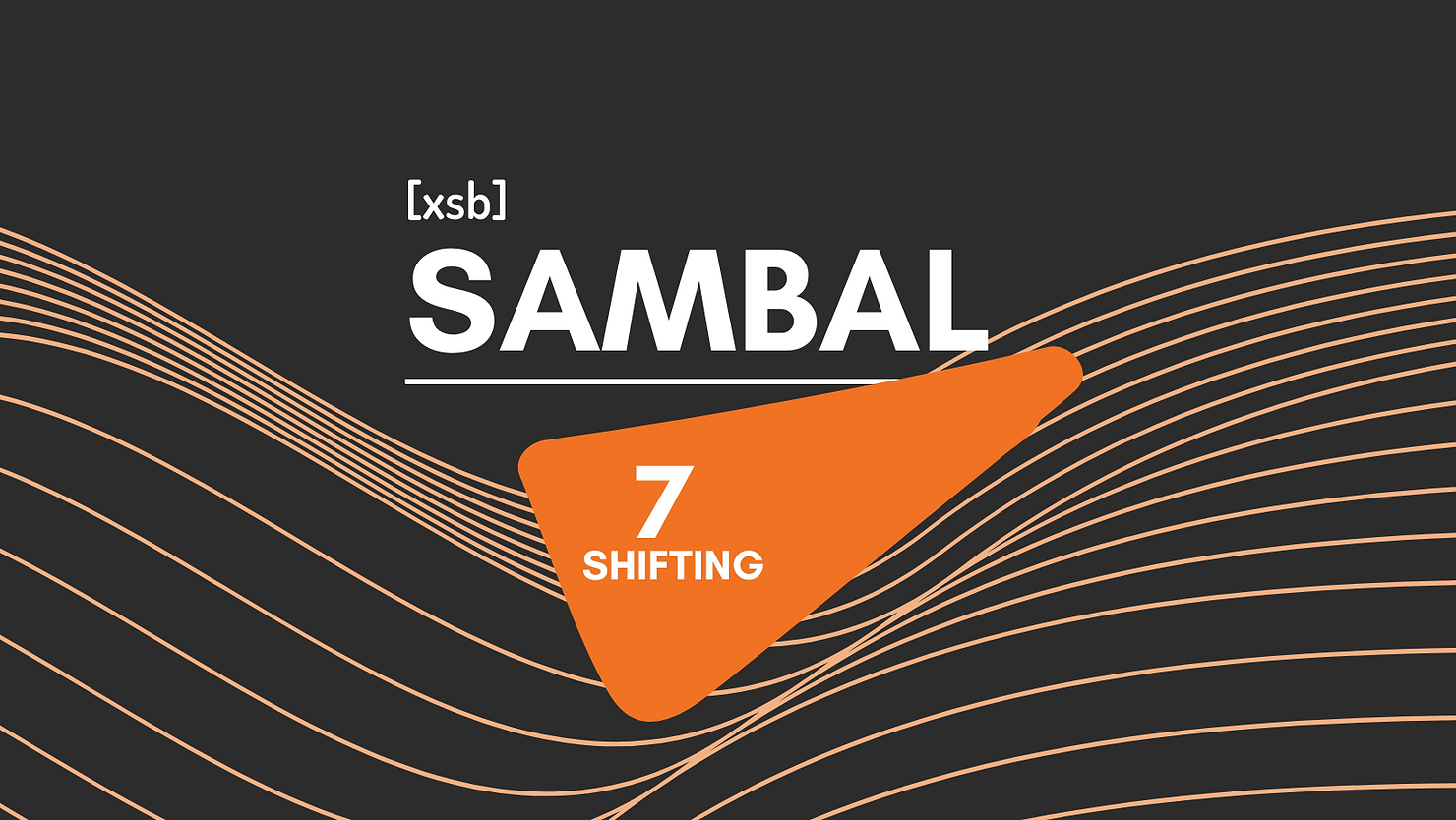Sambal
Sambal [xsb], a language subgrouped under the Sambalic languages of Central Luzon, is spoken by a decreasing population of 70,000 (SIL, 2000, as cited in Eberhard et al., 2022). The language is used in two villages in Pangasinan, five towns in Zambales, the western border of Tarlac, and the Panitian village of Quezon, Palawan. It is also known as Sambal Tina or Tina Sambal, and has dialects in other parts of Zambales like Santa Cruz, Masinloc, and Iba. Speakers of Sambal have 70% intelligibility with Botolan [sbl] (Eberhard et al., 2022), and Sambal has many cognates in Bolinao [smk] (Stone, 2006).

Ways of life
Like other Negrito groups, Sambal people originally hunted animals and gathered resources but sudden changes in their ecosystem affected their source of sustenance. People eventually learned swidden farming and other kinds of agricultural activities on mountain slopes (Brosius, 1983). The main reasons for these changes are private activities in the mountains such as mining and lumbering, as well as the eruption of Mt. Pinatubo in 1991. Through Republic Act 1160 or the institution of the National Resettlement and Rehabilitation Administration (NARRA) in 1956, a group of landless Sambal farmers was also relocated to a village in Palawan.
Language vitality
Sambal is considered a shifting language (EGIDS 7) spoken by the child-bearing generation but no longer transmitted to the children of native speakers. There are no Sambal monolinguals since speakers also use Filipino [fil] and Ilocano [ilo]. The youngsters who do not pursue higher education speak Sambal when working within the community but not when they are with people living outside the area. Sambal is used more often in oral communication than in written form, specifically in local commerce, religious activities, and political campaigning (Eberhard et al., 2022).
Resources on Sambal
A variety of materials on the Sambal language can be found online. The Open Language Archives Community (OLAC) has a comprehensive list of Sambal primary texts, language descriptions, and other resources. DepEd Zambales has translations of several children’s stories on their website. Audio and video resources featuring the language are mostly spoken or read religious content, and some can be found on websites like Global Recordings Network, Bible.is, and Jesus Film Project. Songs sung in Sambal such as “Pwede Duman, Inaro ko?” and “Hanggang Main Biyay” are also available on YouTube.

References
Asian Development Bank. (2002). Indigenous peoples/ethnic minorities and poverty reduction: Philippines. https://think-asia.org/handle/11540/2965
Brosius, J. P. (1983). The Zambales Negritos: Swidden agriculture and environmental change. Philippine Quarterly of Culture and Society, 11(2/3), 123-148. https://www.jstor.org/stable/29791791
Cariño, J. K. (2012). Country technical note on indigenous people’s issues: Republic of the Philippines. International Fund for Agricultural Development. https://www.ifad.org/documents/38714170/40224860/philippines_ctn.pdf/ae0faa4a-2b65-4026-8d42-219db776c50d#:~:text=Indigenous%20peoples%20roughly%20constitute%2010,in%20Visayas%20(NCIP%202009)
Department of Education Zambales. (n.d.). Translated big books: Sambal Tina. Retrieved January 9, 2022, from http://lrmdc.depedzambales.ph/books/translated-big-books/sambal-tina/
Eberhard, D. M., Simons, G. F., & Fennig, C. D. (Eds.). (2022). Sambal. Ethnologue: Languages of the world (25th ed.). https://www.ethnologue.com/language/xsb
Faith Comes By Hearing. (n.d.). Sambal 1999 edition. Bible.is. https://live.bible.is/bible/XSBWYI
Global Recordings Network. (n.d.). Words of life – Sambal [Video]. https://globalrecordings.net/en/program/7931
Guianan, D. M. (2014). Interrogativity as interpersonal stance markers in Sambal language. UE Research Bulletin, 16(1). https://ejournals.ph/article.php?id=1160
Hammarström, H., Forkel, R., Haspelmath, M., & Bank, S. (Eds.). (2022). Spoken L1 language: Tiná Sambal. Glottolog 4.6. https://glottolog.org/resource/languoid/id/tina1248
Jesus Film Project. (n.d.). Jesus [Video]. https://www.jesusfilm.org/watch/jesus.html/sambal.html.
Open Language Archives Community. (n.d.). OLAC resources in and about the Sambal language. Retrieved January 9, 2022, from http://www.language-archives.org/language/xsb
Peralta, J. T. (2000). Glimpses: Peoples of the Philippines. National Commission for Culture and the Arts. https://ncca.gov.ph/about-culture-and-arts/culture-profile/glimpses-peoples-of-the-philippines/
Polyglots’ Philippine Languages. (Uploader). Echon, R. (Singer). (2021, January 9). Hanggang main biyay? (Tina Sambal song) [Video]. YouTube. https://www.youtube.com/watch?v=et_-4lHT6YQ
Polyglots’ Philippine Languages. (Uploader). Echon, R. (Singer). (2021, August 7). Pwede duman, inaro ko? (Sambal song) [Video]. YouTube. https://www.youtube.com/watch?v=J1GY7KA7QYQ
Stone, R. (2006). The Sambalic languages of Central Luzon. Tenth International Conference on Austronesian Linguistics. https://sil-philippines-languages.org/ical/papers/stone-The%20Sambalic%20Languages%20of%20Central%20Luzon.pdf

